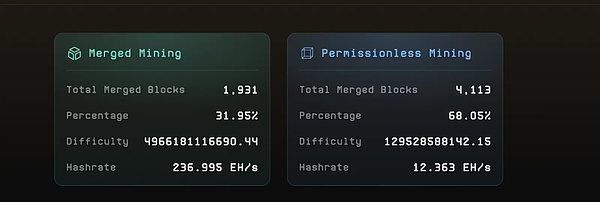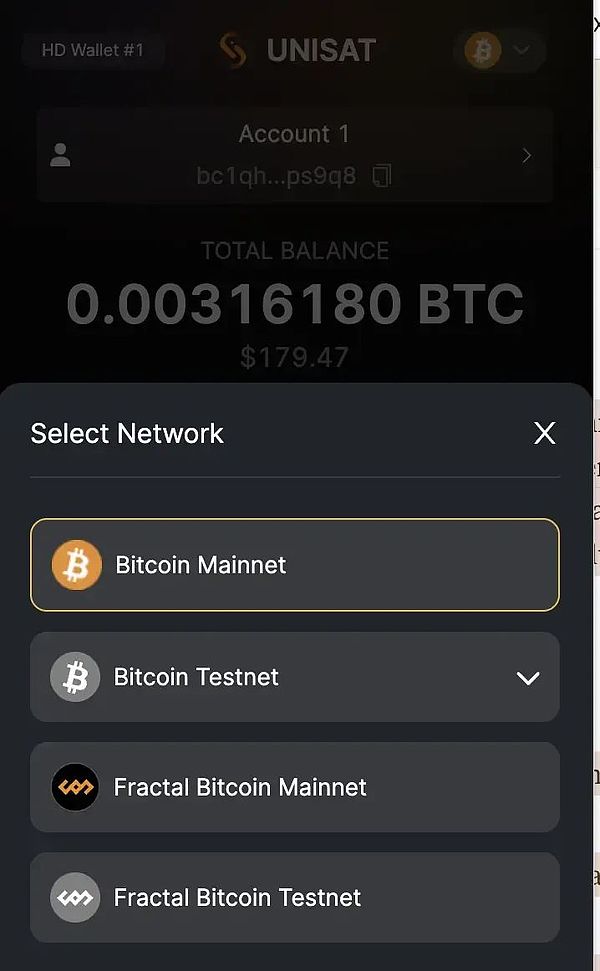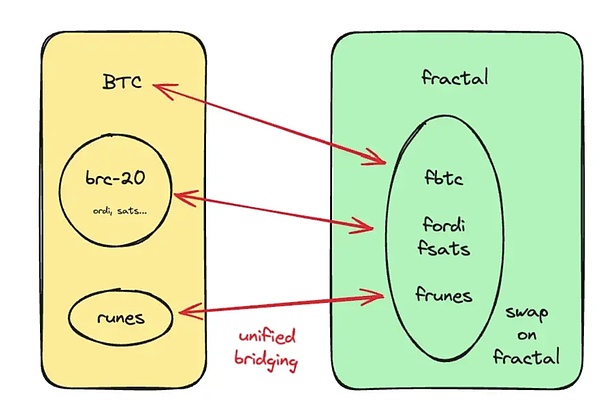Source: XYZ Labs
What is Fractal Bitcoin?
Fractal Bitcoin is an innovative blockchain expansion solution based on recursive virtualization technology that enhances Bitcoin's scalability by creating a multi-layer network structure while maintaining a secure connection with the main network.
The creation of Fractal Bitcoin stems from the emergence of the Ordinals protocol and related applications in 2023. For security reasons, Bitcoin has imposed restrictions on opcodes and block storage space in its iterations. When the Bitcoin chain ecosystem develops rapidly, there are limitations in on-chain computing power and block space, so developers have proposed the concept of Fractal Bitcoin, hoping to solve the shortcomings of the Bitcoin network.
Technical architecture features of Fractal Bitcoin:
1. Shorten the block time of Bitcoin from 10 minutes to 30 seconds, confirm transactions more quickly, greatly improve user experience, increase the overall throughput of the network, and support a wider range of complex applications that require high transaction volume.
2. A unique hybrid mining method is adopted. Two of every three blocks are mined without permission, and the other is jointly mined with Bitcoin. The powerful computing power of Bitcoin is used to enhance security, while allowing individual miners to freely participate in two-thirds of the block production, encouraging decentralization.
3. Fractal implements Turing-complete smart contracts on a Bitcoin-based platform, a feature that provides possibilities for advanced DeFi protocols, complex NFT mechanisms, and other decentralized applications that were previously limited to the Ethereum platform.
4. Maintains 100% compatibility with Bitcoin standards such as BRC-20 and Ordinals.
5. Allows different applications to run their own network layers, and games and DeFi can operate separately on different independent network layers.
Why will Bitcoin expansion become the next focus in the blockchain industry?
Blockchain technology continues to advance. As the earliest and most widely accepted cryptocurrency, Bitcoin still plays an important role worldwide.
However, with the popularity of its network, scalability issues have gradually become prominent, and bottlenecks such as slow transaction confirmation and limited processing capacity have become challenges that need to be urgently solved. To understand why Bitcoin expansion has become the next focus of the blockchain industry, you need to understand the historical background of the discussion on Bitcoin expansion. In 2017, the Segregated Witness (SegWit) soft fork aimed to increase Bitcoin's block capacity, followed by the controversial Bitcoin Cash hard fork as another expansion method. Since 2018, more and more attention has turned to second-layer solutions, such as the Lightning Network. In this ongoing exploration of Bitcoin's scalability and functional enhancements, more and more unique perspectives on the long-term expansion challenges have gradually emerged in the market.
Especially as the crypto market enters 2023, the high requirements for network scalability of the Inscription Protocol and a number of new protocols that have rapidly emerged based on the Bitcoin network, such as brc20 and brc420, determine that Bitcoin expansion will still be the next focus of the industry. New expansion technologies need to achieve this goal by creating independent blockchains that can interoperate with the Bitcoin main network. It is necessary to support two-way anchoring, allowing the functionality of Bitcoin to be enhanced without changing the main network, experimenting with new features and applications, moving transactions off the main blockchain to solve scalability issues, and supporting multiple use cases such as smart contracts and decentralized applications, thereby broadening the utility of Bitcoin and promoting innovation within its ecosystem.
As a major innovation in scaling technology in the new cycle, Fractal's mainnet was officially launched at 00:00 UTC on September 9, 2024. After the launch, the strong appeal of this scaling technology to the market was demonstrated. Within just 24 hours of the mainnet launch, Fractal's joint mining accounted for more than 40% of Bitcoin's total computing power, and free mining on Fractal accounted for 2% of Bitcoin's computing power. The rapid adoption of miners also shows the market's high confidence in Fractal's technology and its potential.

Data source: https://explorer.unisat.io/fractal-mainnet/mining
Comparison of Fractal Bitcoin with other scaling solutions
Unlike other Bitcoin Layer 2 solutions, the wallet address on Fractal is exactly the same as the mainnet address. This design provides Ethereum-like convenience, where users can access different layers by simply switching networks in UniSat or OKX wallets. Unlike other Bitcoin Layer 2 solutions that require a separate EVM wallet address, Fractal allows users to continue using the Bitcoin mainnet address in Layer 2 activities. As of now, major wallets such as OKX Wallet and UniSat Wallet, which serve most active Bitcoin DeFi and collectibles users, fully support Fractal Bitcoin.

How it compares to some major alternatives:
1. EVM-compatible Layer 2: Some projects have attempted to create EVM-based second-layer solutions for Bitcoin. While these solutions are relatively easy to implement and launch, they face significant challenges in terms of acceptance by the Bitcoin community. In contrast, Fractal takes a Bitcoin-native approach that may be more in line with the philosophy of Bitcoin purists and may lead to better integration and adoption in the existing Bitcoin ecosystem.
2. Bitcoin Cash (BCH): Bitcoin Cash emerged as a hard fork of Bitcoin, aiming to improve scalability through a larger block size. This approach has led to divisions within the Bitcoin community and forced users to choose between two competing visions of Bitcoin. In contrast, rather than creating a separate chain or forcing users to make a choice, Fractal embraces Bitcoin as the mainnet and seeks to natively scale it. Fractal's architecture allows for the creation of multiple instances to scale together, potentially providing unlimited scalability without sacrificing the security or decentralization of the base layer.
3. Lightning Network: The Lightning Network excels in fast, low-cost payments and high privacy, but its smart contract functionality is limited and it faces channel liquidity issues. In contrast, Fractal provides comprehensive smart contract support, does not require channel management, and provides a simpler user experience.
In general, Fractal Bitcoin maintains the basic security and reliability of the Bitcoin network and increases scalability. Create multiple independent layers on the Bitcoin blockchain. Each layer runs as an independent instance, but is still anchored to the main Bitcoin network. This layered architecture allows Fractal Bitcoin to distribute transaction loads, with each layer being able to handle a large number of transactions simultaneously. To manage these layers, Fractal Bitcoin implements a dynamic load balancing system. This system is able to flexibly allocate resources and distribute transactions based on fluctuations in transaction demand, preventing any single layer from becoming a bottleneck. To enable cross-layer asset transfers, Fractal Bitcoin uses a rotating multi-party computation (MPC) signature system. This system allows efficient and secure asset transfers without the need for users to wrap their tokens, maintaining the integrity and availability of assets within the ecosystem.

In actual applications, Fractal Bitcoin creates dedicated instances for specific purposes. For example, it creates a dedicated instance for ordinals, ensuring 100% compatibility and optimizing the processing of these assets. This dedicated instance uses a mechanism to lock and map specific satoshis on the main chain to the instance, allowing ordinals to circulate seamlessly within the instance while ensuring that they retain the original inscription when they return to the main chain.
Fractal Bitcoin Ecosystem
Wallet
1. @unisat_wallet: The team behind Fractal Bitcoin, with early $FB airdrop qualification
2. @okxweb3: Also supports Fractal Bitcoin, the second wallet with early $FB airdrop qualification
Data/Trading Tools
1. @cryptohunt_ai: Fractal Twitter information aggregator, including cat20 mint guide tutorial, and project analysis
2. @mctxyz: On-chain toolbox, comprehensive functions, capable of batch transfer, batch balance check, UTXO split, etc.
3. Fractal Pool List: Find a list of fractal mining pools and their hashrate, fees and payment methods
4. @unisat_wallet: View mining hashrate and difficulty
5. @mempool: Block explorer
6. @OKLink: Block explorer
7. @FractalBotx: Create, exchange and earn via Telegram bot
CAT20 protocol tool
1. @cryptohunt_ai: Proxy tool, low cost and fast speed, real-time dashboard to view Mint progress
2. @cointool: Proxy, CAT20 batch balance query, batch transfer
3. @dot_swap: Proxy tool
 JinseFinance
JinseFinance
 JinseFinance
JinseFinance JinseFinance
JinseFinance JinseFinance
JinseFinance JinseFinance
JinseFinance JinseFinance
JinseFinance JinseFinance
JinseFinance JinseFinance
JinseFinance JinseFinance
JinseFinance JinseFinance
JinseFinance JinseFinance
JinseFinance